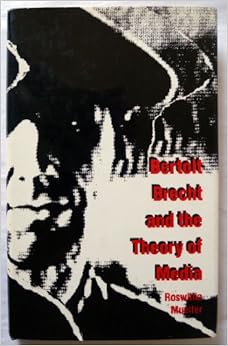Roswitha Mueller: Bertolt Brecht and the Theory of Media (1989)
Filed under book | Tags: · aesthetics, cinema, film, film theory, media, media theory, opera, politics, radio, theatre

Bertolt Brecht spent a career puncturing artistic illusion while casting a spell as an innovator that has continued since his death in 1956. Best known to theater goers for “The Threepenny Opera,” “Mother Courage and her Children,” “The Caucasian Chalk Circle” and other production, the great playwright was, in fact, a man of all media. He was interested in radio and the cinema as soon as they appeared in Europe and brought to them, as well as to the stage, a dramatic theory so radical and influential that it has come to be known by the adjective “Brechtian.”
Publisher University of Nebraska Press, Lincoln & London, 1989
Modern German Culture and Literature series
ISBN 0803231326, 9780803231320
149 pages
Reviews: Katie Trumpener, Susan Bennett (Theatre Research International).
PDF (no OCR)
Comment (0)Geoff Waite: Nietzsche’s Corps/e: Aesthetics, Politics, Prophecy, or, the Spectacular Technoculture of Everyday Life (1996)
Filed under book | Tags: · aesthetics, communism, esotericism, everyday, left, life, philosophy, politics

“Appearing in 1996 between two historical touchstones—the alleged end of communism and the 100th anniversary of Nietzsche’s death—this book offers a provocative hypothesis about the philosopher’s afterlife and the fate of leftist thought and culture. At issue is the relation of the dead Nietzsche (corpse) and his written work (corpus) to subsequent living Nietzscheanism across the political spectrum, but primarily among a leftist corps that has been programmed and manipulated by concealed dimensions of the philosopher’s thought. If anyone is responsible for what Geoff Waite maintains is the illusory death of communism, it is Nietzsche, the man and concept.
Waite advances his argument by bringing Marxist—especially Gramscian and Althusserian—theories to bear on the concept of Nietzsche/anism. But he also goes beyond ideological convictions to explore the vast Nietzschean influence that proliferates throughout the marketplace of contemporary philosophy, political and literary theory, and cultural and technocultural criticism. In light of a philological reconstruction of Nietzsche’s published and unpublished texts, Nietzsche’s Corps/e shuttles between philosophy and everyday popular culture and shows them to be equally significant in their having been influenced by Nietzsche—in however distorted a form and in a way that compromises all of our best interests.
Controversial in its “decelebration” of Nietzsche, this remarkable study asks whether the postcontemporary age already upon us will continue to be dominated and oriented by the haunting spectre of Nietzsche’s corps/e. Philosophers, intellectual historians, literary theorists, and those interested in western Marxism, popular culture, Friedrich Nietzsche, and the intersection of French and German thought will find this book both appealing and challenging.”
Publisher Duke University Press, 1996
ISBN 0822317192, 9780822317197
xii+564 pages
Review: Douglas Kellner (Illuminations, (2)), Ricardo Dominguez (Thing, 1996), Carl Pletsch and James A. Winders (Modernism/modernity, 1998), Tracy B. Strong (New Nietzsche Studies, 1998), Paul Bishop (Modern Language Rev, 1999), Richard E. Joines (Rethinking Marxism, 2001, (2)).
See also Pierre Klossowski’s Nietzsche and the Vicious Circle (1969–)
Comment (0)Akin Adesokan: Postcolonial Artists and Global Aesthetics (2011)
Filed under book | Tags: · aesthetics, africa, art, cinema, film, neoliberalism, nollywood, politics, postcolonialism

“What happens when social and political processes such as globalization shape cultural production? Drawing on a range of writers and filmmakers from Africa and elsewhere, Akin Adesokan explores the forces at work in the production and circulation of culture in a globalized world. He tackles problems such as artistic representation in the era of decolonization, the uneven development of aesthetics across the world, and the impact of location and commodity culture on genres, with a distinctive approach that exposes the global processes transforming cultural forms.”
Publisher Indiana University Press, 2011
African Expressive Cultures series
ISBN 0253356792, 9780253356796
230 pages
PDF (updated on 2021-1-28)
Comments (2)
